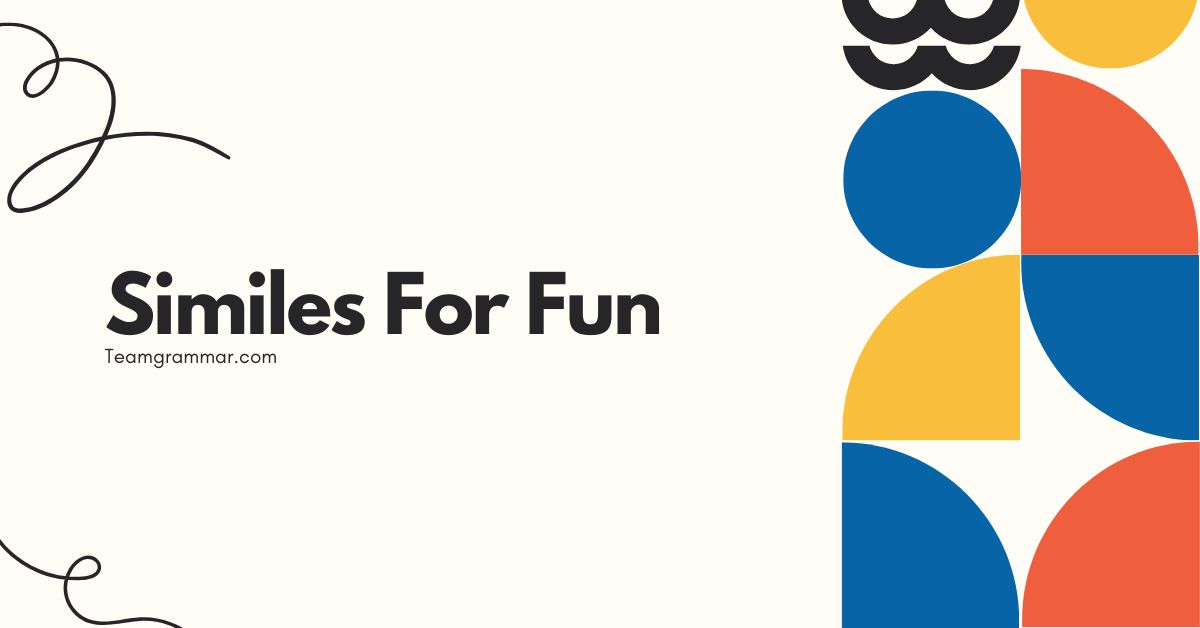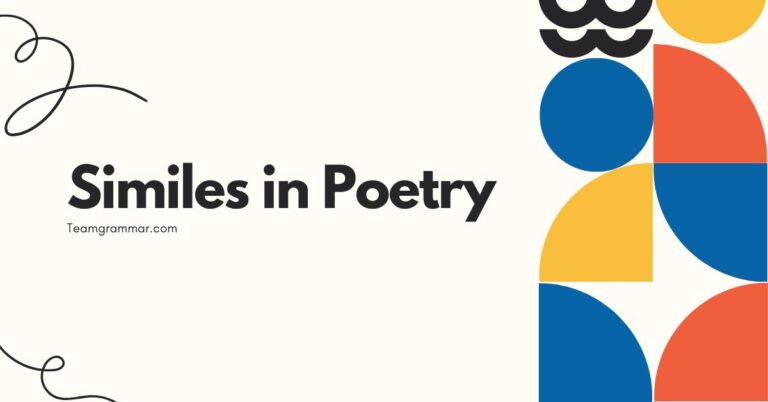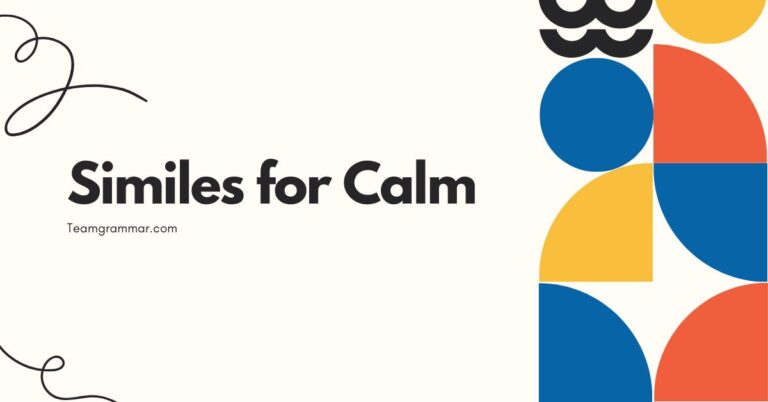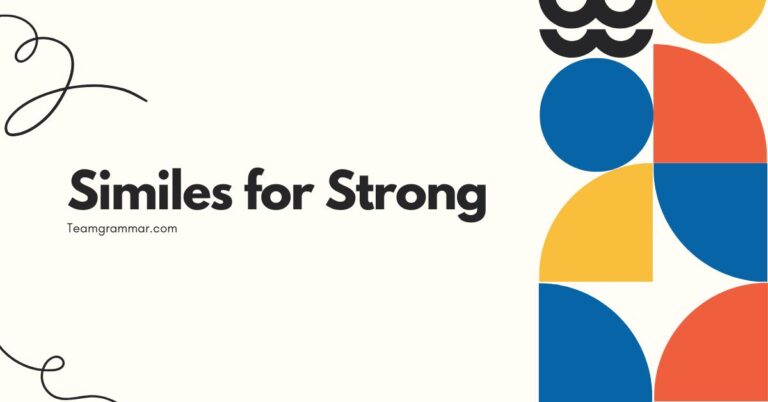49 Similes For Fun: Mastering Figurative Language
Similes are powerful tools in the English language, allowing writers and speakers to create vivid imagery and make their communication more engaging. Understanding similes is crucial for both comprehending literature and enhancing one’s own writing.
This article will explore the definition, structure, types, and usage of similes, providing numerous examples and exercises to help you master this figurative language device. Whether you are a student, a writer, or simply someone who wants to improve their English skills, this guide will offer valuable insights and practical techniques.
Table of Contents
- Definition of Similes
- Structural Breakdown of Similes
- Types of Similes
- Examples of Similes
- Usage Rules for Similes
- Common Mistakes with Similes
- Practice Exercises
- Advanced Topics in Similes
- Frequently Asked Questions (FAQ)
- Conclusion
Definition of Similes
A simile is a figure of speech that directly compares two different things using the words “like” or “as.” The purpose of a simile is to create a more vivid and descriptive image in the reader’s mind by highlighting the similarities between the two things being compared. Similes are essential tools for writers and speakers who want to add color and depth to their language.
They are found extensively in literature, poetry, and everyday conversation, making their understanding crucial for effective communication.
Similes differ from metaphors, which also compare two things but do so implicitly, without using “like” or “as.” While a simile states that something *is like* something else, a metaphor states that something *is* something else. For example, “He is as brave as a lion” is a simile, whereas “He is a lion” is a metaphor.
Both figures of speech enhance understanding and create imagery, but they achieve this through different mechanisms.
The classification of similes falls under the broader category of figurative language, which includes other devices such as metaphors, personification, hyperbole, and irony. Figurative language deviates from the literal meaning of words to create a more impactful and expressive effect.
Similes function to provide clarity and emphasis by drawing parallels between familiar and unfamiliar concepts. They are particularly useful for explaining complex ideas or evoking emotional responses.
Structural Breakdown of Similes
The basic structure of a simile involves three key components: the **subject**, the **linking word** (“like” or “as”), and the **object of comparison**. The subject is the thing being described, while the object of comparison is the thing it is being compared to.
The linking word establishes the connection between the two. Understanding this structure is essential for both recognizing and creating effective similes.
The formula for a simile can be represented as: Subject + Linking Word (like/as) + Object of Comparison. For instance, in the simile “The sky is as blue as the ocean,” the subject is “the sky,” the linking word is “as,” and the object of comparison is “the ocean.” This simple structure allows for a wide range of creative expression, as the subject and object of comparison can be virtually anything.
The effectiveness of a simile often depends on the aptness of the comparison. The more relevant and insightful the connection between the subject and object of comparison, the more impactful the simile will be.
A strong simile will not only create a vivid image but also provide a new perspective on the subject being described. Consider the simile “Her smile was like sunshine.” This comparison evokes feelings of warmth, happiness, and brightness, enhancing the reader’s understanding of her smile.
Types of Similes
Similes can be categorized based on the nature of the comparison they make. While all similes use “like” or “as” to draw a comparison, the type of comparison can vary.
Here, we will explore three main types of similes: positive, negative, and ironic.
Positive Similes
Positive similes are used to highlight a favorable quality or characteristic of the subject. They often evoke positive emotions or create a sense of admiration.
These similes are commonly used to praise, compliment, or emphasize the positive attributes of someone or something.
For example, “He is as strong as an ox” is a positive simile because it emphasizes the subject’s strength, which is generally considered a desirable trait. Similarly, “She sings like an angel” highlights the beauty and purity of her voice.
Positive similes are effective for creating a positive impression and conveying admiration.
Negative Similes
Negative similes, conversely, are used to highlight an unfavorable quality or characteristic of the subject. They often evoke negative emotions or create a sense of disapproval.
These similes are commonly used to criticize, condemn, or emphasize the negative attributes of someone or something.
For example, “He is as stubborn as a mule” is a negative simile because it emphasizes the subject’s stubbornness, which is generally considered an undesirable trait. Similarly, “She is as cold as ice” highlights the lack of warmth and empathy in her personality.
Negative similes are effective for creating a negative impression and conveying disapproval.
Ironic Similes
Ironic similes are used to create a contrast between what is said and what is actually meant. They often involve comparing the subject to something that is the opposite of what is intended.
These similes can be used for humorous effect or to convey sarcasm or cynicism.
For example, “He is as sharp as a marble” is an ironic simile because it compares the subject to something that is known to be dull and lacking in intelligence. Similarly, “She is as graceful as a newborn giraffe” highlights the subject’s clumsiness by comparing her to something that is inherently awkward.
Ironic similes are effective for adding humor and conveying a sense of irony.
Examples of Similes
Similes are versatile and can be used to describe a wide range of subjects, from people and places to emotions and actions. The following sections provide numerous examples of similes organized by category.
Common Similes
These are similes that are frequently used in everyday conversation and writing. They are often well-known and easily understood.
The table below presents a comprehensive list of common similes, illustrating their usage and meaning.
| Simile | Meaning |
|---|---|
| As busy as a bee | Very busy and active |
| As blind as a bat | Having poor eyesight |
| As brave as a lion | Very courageous |
| As cold as ice | Lacking warmth or emotion |
| As clear as crystal | Very clear and easy to understand |
| As different as night and day | Completely different |
| As dry as a bone | Very dry |
| As easy as pie | Very easy |
| As fast as lightning | Very fast |
| As fit as a fiddle | In very good health |
| As gentle as a lamb | Very gentle and kind |
| As good as gold | Well-behaved and obedient |
| As green as grass | Very environmentally friendly/naive |
| As happy as a clam | Very happy |
| As hungry as a bear | Very hungry |
| As light as a feather | Very light in weight |
| As old as the hills | Very old |
| As pale as a ghost | Very pale |
| As quiet as a mouse | Very quiet |
| As red as a rose | Very red |
| As sharp as a tack | Very intelligent |
| As sick as a dog | Very sick |
| As slippery as an eel | Difficult to catch or hold |
| As slow as molasses | Very slow |
| As smooth as silk | Very smooth |
| As solid as a rock | Very stable and reliable |
| As sour as a lemon | Very sour |
| As still as a statue | Motionless |
| As straight as an arrow | Very straight |
| As strong as an ox | Very strong |
Similes for Describing People
Similes can be used to describe a person’s appearance, personality, or behavior. They help to create a more vivid and engaging portrait of the individual.
The table below offers various similes that can be used to describe different aspects of a person’s character and physical attributes.
| Simile | Description |
|---|---|
| As tall as a giraffe | Very tall |
| As thin as a rail | Very thin |
| As loud as a foghorn | Very loud |
| As quiet as a shadow | Very quiet and unobtrusive |
| As quick as a bunny | Very quick and agile |
| As clumsy as a bull in a china shop | Very clumsy and awkward |
| As graceful as a swan | Very graceful and elegant |
| As wise as an owl | Very wise and knowledgeable |
| As innocent as a lamb | Very innocent and naive |
| As sly as a fox | Very cunning and deceptive |
| As stubborn as a mule | Very stubborn and obstinate |
| As busy as a beaver | Very busy and industrious |
| As proud as a peacock | Very proud and vain |
| As fierce as a tiger | Very fierce and aggressive |
| As gentle as a breeze | Very gentle and kind |
| As warm as the sun | Very warm and friendly |
| As cold as ice | Emotionally cold and distant |
| As sharp as a razor | Very intelligent and perceptive |
| As dull as dishwater | Very boring and uninteresting |
| As nutty as a fruitcake | Eccentric or crazy |
| As nutty as a fruitcake | Eccentric or crazy |
| As tough as nails | Strong and resilient |
| As easygoing as Sunday morning | Relaxed and carefree |
| As predictable as the sunrise | Very predictable |
| As reliable as clockwork | Very reliable |
| As bubbly as champagne | Enthusiastic and cheerful |
| As mysterious as the moon | Enigmatic and intriguing |
| As grounded as an oak | Stable and level-headed |
| As radiant as the sun | Glowing and beautiful |
| As soothing as rain | Calming and comforting |
Similes for Describing Places
Similes can be used to describe the atmosphere, appearance, or characteristics of a place. They help to create a more immersive and evocative sense of the location.
The table below provides similes suitable for describing different types of places, enhancing the reader’s visualization.
| Simile | Description |
|---|---|
| As quiet as a library | Very quiet and peaceful |
| As busy as a train station | Very busy and bustling |
| As dark as a cave | Very dark and gloomy |
| As bright as a sunny day | Very bright and cheerful |
| As cold as a freezer | Very cold and frigid |
| As hot as a furnace | Very hot and scorching |
| As clean as a whistle | Very clean and spotless |
| As messy as a pigsty | Very messy and disorganized |
| As peaceful as a garden | Very peaceful and serene |
| As lively as a carnival | Very lively and exciting |
| As grand as a palace | Very grand and imposing |
| As small as a dollhouse | Very small and compact |
| As bleak as a desert | Very bleak and desolate |
| As lush as a rainforest | Very lush and verdant |
| As inviting as a warm fire | Very inviting and welcoming |
| As intimidating as a fortress | Very intimidating and formidable |
| As enchanting as a fairy tale | Very enchanting and magical |
| As timeless as the mountains | Timeless and enduring |
| As vibrant as a coral reef | Vibrant and colorful |
| As familiar as home | Comfortable and well-known |
| As deadly as a graveyard | Grim and ominous |
| As sterile as a lab | Clean and clinical |
| As vast as the ocean | Endless and intimidating |
| As suffocating as a crowd | Overwhelming and unpleasant |
| As remote as the moon | Isolated and distant |
| As claustrophobic as a submarine | Confined and restricting |
| As serene as a temple | Peaceful and meditative |
| As charming as a cottage | Quaint and inviting |
| As otherworldly as Mars | Strange and alien |
| As bustling as Times Square | Energetic and crowded |
Similes for Describing Emotions
Similes can be used to describe the intensity, nature, or impact of an emotion. They help to convey the feeling in a more relatable and understandable way.
The table below provides similes to describe various emotions, helping to convey feelings vividly.
| Simile | Description |
|---|---|
| As happy as a lark | Very happy and cheerful |
| As sad as a willow | Very sad and mournful |
| As angry as a hornet | Very angry and agitated |
| As calm as a still lake | Very calm and peaceful |
| As excited as a kid on Christmas | Very excited and enthusiastic |
| As scared as a mouse | Very scared and frightened |
| As surprised as a deer in headlights | Very surprised and shocked |
| As nervous as a long-tailed cat in a room full of rocking chairs. | Very nervous and anxious |
| As relieved as a prisoner set free | Very relieved and grateful |
| As jealous as a green-eyed monster | Very jealous and envious |
| As confused as a chameleon in a bag of Skittles | Very confused and bewildered |
| As content as a cat in a sunbeam | Very content and satisfied |
| As lonely as a cloud | Very lonely and isolated |
| As hopeful as a spring flower | Very hopeful and optimistic |
| As frustrated as a Rubik’s Cube | Very frustrated and exasperated |
| As guilty as sin | Very guilty and remorseful |
| As empty as a well | Emotionally empty and hollow |
| As light as a feather | Feeling carefree and happy |
| As heavy as lead | Feeling burdened and weighed down |
| As bitter as coffee | Resentful and disappointed |
| As numb as ice | Emotionally detached |
| As wild as fire | Uncontrollable and intense |
| As crushing as a falling sky | Overwhelming and devastating |
| As fragile as glass | Vulnerable and easily hurt |
| As fleeting as a dream | Temporary and disappearing |
| As sweet as honey | Delightful and pleasant |
| As crushing as a tidal wave | Overwhelmed by sorrow |
| As raw as an open wound | Vulnerable and painful |
| As brittle as aged paper | Easily broken and fragile |
| As deep as an ocean | Profound and intense |
Similes for Describing Actions
Similes can be used to describe the manner, speed, or impact of an action. They help to create a more dynamic and engaging description.
The table below provides similes to describe different types of actions, adding dynamism to descriptions.
| Simile | Description |
|---|---|
| Runs like the wind | Runs very fast |
| Eats like a horse | Eats a lot |
| Sleeps like a log | Sleeps very soundly |
| Fights like a wildcat | Fights fiercely |
| Sings like an angel | Sings beautifully |
| Works like a dog | Works very hard |
| Drinks like a fish | Drinks a lot of alcohol |
| Swims like a fish | Swims very well |
| Dances like a dream | Dances gracefully |
| Cries like a baby | Cries uncontrollably |
| Screams like a banshee | Screams loudly and shrilly |
| Moves like molasses | Moves very slowly |
| Roars like a lion | Roars loudly and powerfully |
| Grows like a weed | Grows quickly and uncontrollably |
| Shines like a star | Shines brightly |
| Falls like a stone | Falls quickly and heavily |
| Melts like butter | Melts quickly and easily |
| Burns like fire | Burns intensely |
| Breaks like glass | Breaks easily |
| Spreads like wildfire | Spreads rapidly |
| Hangs like a shadow | Clings closely |
| Cuts like a knife | Pierces sharply |
| Creeps like a snail | Moves very slowly |
| Explodes like a bomb | Reacts violently |
| Hunts like a hawk | Searches intently |
| Hides like an ostrich | Avoids confrontation |
| Gathers like dust | Accumulates gradually |
| Glows like embers | Shines faintly |
| Floats like a cloud | Moves lightly |
| Crawls like a baby | Moves on hands and knees |
Usage Rules for Similes
While similes offer creative freedom, there are certain rules to follow to ensure their effective use. A key principle is to ensure the comparison is clear and relevant.
The two things being compared should share a recognizable similarity that enhances the reader’s understanding.
Avoid using clichéd similes, as they can sound unoriginal and lack impact. Instead, strive to create fresh and imaginative comparisons that will capture the reader’s attention.
For example, instead of saying “as red as a rose,” consider a more unique simile such as “as red as a freshly painted fire hydrant.”
Ensure that the simile is appropriate for the context and tone of your writing. A humorous simile may not be suitable for a serious or formal piece.
Consider your audience and the overall message you are trying to convey when choosing or creating similes.
Be mindful of cultural differences and avoid using similes that may be offensive or misunderstood in certain cultures. A simile that is common and harmless in one culture may have a different connotation in another.
Always consider the potential impact of your language on your audience.
Common Mistakes with Similes
One common mistake is confusing similes with metaphors. Remember that similes use “like” or “as” to make a comparison, whereas metaphors make an implicit comparison without these words.
For example, “He is like a rock” is a simile, while “He is a rock” is a metaphor.
Another mistake is using illogical or unclear comparisons. The two things being compared should have a clear and understandable connection.
Avoid similes that are confusing or nonsensical. For example, “The car is as fast as a turtle” is an illogical simile because cars are generally much faster than turtles.
Overusing similes can also diminish their impact. Use similes sparingly and strategically to enhance your writing, rather than relying on them excessively.
Too many similes can make your writing sound contrived and distracting.
Failure to consider cultural context is also a common mistake. Similes can be culturally specific, and what resonates in one culture might not in another.
Always consider your audience and whether the comparison will be understood correctly.
The table below illustrates some common mistakes with similes, along with corrections.
| Incorrect | Correct | Explanation |
|---|---|---|
| He is a rock (Simile) | He is like a rock (Simile) | Confusing a metaphor with a simile. |
| The car is as fast as a turtle. | The car is as fast as a racecar. | Illogical comparison. |
| The sky is as blue as a banana. | The sky is as blue as the ocean. | Unclear comparison. |
| He fought like a. | He fought like a lion. | Incomplete simile. |
Practice Exercises
The following exercises will help you practice identifying, completing, and writing similes.
Exercise 1: Identifying Similes
Identify the similes in the following sentences.
| Question | Answer |
|---|---|
| 1. The snow was as white as milk. | as white as milk |
| 2. Her voice is like a melody. | is like a melody |
| 3. He ran fast. | No simile present |
| 4. The baby slept like a log. | slept like a log |
| 5. The sun is a star. | No simile present |
| 6. She is as bright as the sun. | as bright as the sun |
| 7. The clouds were fluffy. | No simile present |
| 8. The cake was as light as a feather. | as light as a feather |
| 9. He roared loudly. | No simile present |
| 10. The wind howled like a wolf. | howled like a wolf |
Exercise 2: Completing Similes
Complete the following similes with an appropriate comparison.
| Question | Answer |
|---|---|
| 1. As brave as __________. | As brave as a lion. |
| 2. As slow as __________. | As slow as molasses. |
| 3. As quiet as __________. | As quiet as a mouse. |
| 4. As strong as __________. | As strong as an ox. |
| 5. As busy as __________. | As busy as a bee. |
| 6. As cold as __________. | As cold as ice. |
| 7. As clear as __________. | As clear as crystal. |
| 8. As dry as __________. | As dry as a bone. |
| 9. As easy as __________. | As easy as pie. |
| 10. As fast as __________. | As fast as lightning. |
Exercise 3: Writing Your Own Similes
Write your own similes to describe the following subjects.
| Subject | Example Simile |
|---|---|
| 1. A sunset | The sunset was as vibrant as a painter’s palette. |
| 2. A crowded street | The street was as bustling as a beehive. |
| 3. A deep forest | The forest was as dark as a mysterious dream. |
| 4. A flowing river | The river flowed like a ribbon through the valley. |
| 5. A starry night | The night sky was as speckled as a trout. |
| 6. A gentle breeze | The breeze was as soft as a whisper. |
| 7. A roaring fire | The fire roared like a caged beast. |
| 8. A peaceful meadow | The meadow was as tranquil as a sleeping child. |
| 9. A busy office | The office was as hectic as a stock exchange. |
| 10. A quiet room | The room was as silent as a tomb. |
Advanced Topics in Similes
For advanced learners, exploring more complex and nuanced aspects of similes can further enhance their understanding and usage. One such aspect is the use of extended similes, which involve developing a single comparison over multiple sentences or paragraphs.
Extended similes allow for a more detailed and elaborate exploration of the similarities between the subject and object of comparison.
Another advanced topic is the use of metaphorical similes, which combine elements of both similes and metaphors. Metaphorical similes use “like” or “as” to introduce a comparison that is inherently metaphorical.
For example, “He is as quick as a shadow” combines the simile structure with the metaphorical concept of shadows being elusive and fast-moving.
Exploring the use of similes in different genres and styles of writing can also provide valuable insights. Similes are used differently in poetry, fiction, and non-fiction, and understanding these nuances can help you tailor your language to suit the specific context.
For instance, poetry often uses more evocative and imaginative similes, while non-fiction may use more straightforward and explanatory similes.
Frequently Asked Questions (FAQ)
- What is the difference between a simile and a metaphor?
A simile is a comparison using “like” or “as,” while a metaphor directly equates two things. For example, “He is like a lion” (simile) versus “He is a lion” (metaphor).
- Can a simile be negative?
Yes, a simile can be negative by highlighting unfavorable qualities. For example, “He is as stubborn as a mule” is a negative simile.
- How can I make my similes more creative?
Avoid clichés and try to find unique and unexpected comparisons. Think about the specific qualities you want to emphasize and find objects or concepts that share those qualities in an interesting way.
- Is it okay to use similes frequently in writing?
Use similes judiciously. Overuse can make your writing seem contrived. Employ them strategically to enhance specific descriptions or explanations.
- What are some common mistakes to avoid when using similes?
Avoid illogical comparisons, clichés, and confusing similes with metaphors. Ensure your comparisons are clear and relevant to the context.
- How do similes enhance writing?
Similes create vivid imagery, clarify complex ideas, and evoke emotional responses, making your writing more engaging and impactful.
- Are similes culturally specific?
Yes
- Are similes culturally specific?
Yes, some similes are culturally specific, and their meanings might not translate well across different cultures. Always consider your audience and the potential for misunderstanding.
Conclusion
Similes are invaluable tools for enriching language and enhancing communication. By understanding their definition, structure, types, and usage rules, you can effectively incorporate similes into your writing and speaking.
Practice identifying, completing, and writing similes to hone your skills and unlock your creative potential. With careful consideration and thoughtful application, similes can transform your language from ordinary to extraordinary.







